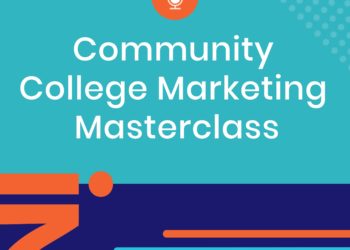
In this episode of the Community College Marketing MasterClass Podcast, Adam Lopez, the Esports Coordinator and coach at Imperial Valley College, joins Interact CEO Dr. Pam Cox-Otto and Student Social… Read More – Esports at Community Colleges
Videos September 05, 2019
When developing messages for your marketing materials, it’s important to keep communication strategies (like dual-processing theory) in mind. In this Quick Tips! video, Dr. Pamela Cox-Otto gives advice on how to approach your college’s messaging so you can connect with more of your potential students.
Hi, everyone. I’m Dr. Pam Cox-Otto, and welcome to Interact’s Community College Marketing Masterclass. Today, we’re going to talk a little bit about something that in communication theory is… Well, it’s basically the unifying theory of persuasion. But we don’t talk about it much, so I want to give you a background and something to be thinking about. There’s a theory called dual-processing theory. Dual-processing theory comes under a lot of different names. There’s an elaboration likelihood model. Yeah, I know, lots of egghead stuff.
The person who summarized it best is Dr. Robert Cialdini, and what he said was this: He said there’s two types of processing that takes place in our minds, right? We are either mindful or mindless. Mindful is when we are thinking about something with all of our brain cells. We are focused on that choice. It takes a lot of our cognitive energy. It’s not something you can do quick. But when we are fully mindful, when we’re fully in that place, we are thinking about all of the options. Think about the first time you bought a house, the first time you bought a car, when you were weighing all of those choices about this or that, “Should I get that option? Do I really need the undercarriage spray coating?” All of those things were mindful, because you were making a choice one tiny piece at a time, right?
Then, think about mindless. Mindless is all of those decisions where you don’t really have time to think about everything, so you just make a choice. For example, what you’re wearing right now. When you got up this morning, did you really go to your closet and think, “What do I have today? Who am I meeting with? What’s my best color? How will I look good standing next to them?” No, you don’t… No one… Well, okay, there’s some of you out there, I know, who do that, but most of us don’t have the time for it. We do it when we’re going out on a special dinner, or a wedding, or a party, but most of the time, we just grab things in our clothes that we go, “Oh, those fit,” and put on socks, and hopefully underwear, and we go out the door, right?
So those are the two ways that we process: mindful and mindless. The reason why it’s important for you to think about that is this: When you are mindfully processing something, and you’re thinking about all of the details, that’s when you are susceptible to messages about quality, and value, and price, and all of those things we typically make arguments for. “Come to this college because it’s a great value, cost per unit, small class size.” All of those are mindful arguments. They assume I’m sitting there going, “Hmm, where am I going to go to school? Look at these two options,” I’m weighing these choices as if it’s a deep, deep thing.
Now, let’s be honest. There are people who are making their choices in a mindful way, but there’s just as many folks who are going, “I like their campus. It’s pretty,” or, “I can get there easily,” or, “It’s just off the 10.” Those are the people that when you write a long article touting all of those reasonable, logical reasons why they should come to your school, are completely unmoved by them. They don’t read it. They don’t take the time, and if they did, none of that would move them. Why? Because they want an emotional reason, something where they immediately feel a connection, right?
Most of the time, when you take materials to your leadership group, your deans, all of those folks, they want you to write something mindful. They want you to use logic. They want you to use facts. And that’s appropriate for a certain group of people, but there’s an equally large group of students who will make that decision mindlessly, and they need to see things like fun, and social life, and cool things happening, and excitement, and energy. Those are emotional reasons that allow them to make their choice, just like you went, “Oh, look, that’s a pretty color,” and got on the clothes you’re wearing right now.
So, what I want you to realize is there’s no right way to do only one version of this. You can’t do only mindful. You can’t do only mindless. You have to do both, and for many of you, that’s going to be an argument with your faculty, giving you permission to make emotional arguments, or funny arguments, or human arguments that reach out and do more than simply giving, “Accessible, affordable, and close to home.”
Now, when you have a choice to make, if you can only do one, frankly, do the emotional one, because the emotional argument will pull them in, make them look, and give you a second chance to give them the logical argument. The logical argument may sell a certain number of folks, but it won’t sell everybody, and those folks who you are missing won’t give you a second chance. So, your marketing must appeal to both mindful and mindless, or you’re going to lose at least half of your audience every single time.
We’re going to talk more about dual-processing theory, because there’s an awful lot of things you should know that will shape your marketing messaging, but time for another day. I’m Dr. Pam Cox-Otto. Thanks for joining me today. This is Interact’s Community College Marketing Masterclass. Take care.

In this episode of the Community College Marketing MasterClass Podcast, Adam Lopez, the Esports Coordinator and coach at Imperial Valley College, joins Interact CEO Dr. Pam Cox-Otto and Student Social… Read More – Esports at Community Colleges


Discovering and understanding your marketing team’s interpersonal needs can potentially help your team be more productive and happier as you ramp up your marketing efforts.